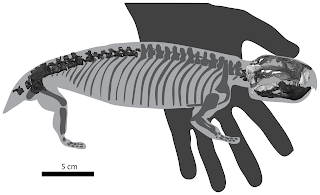Bringing Dicynodonts Back to Life: Paleobiology and Anatomy of a New Emydopoid Genus from the Upper Permian of Mozambique
Authors:
Castanhinha et al
Abstract:
Dicynodontia represent the most diverse tetrapod group during the Late Permian. They survived the Permo-Triassic extinction and are central to understanding Permo-Triassic terrestrial ecosystems. Although extensively studied, several aspects of dicynodont paleobiology such as, neuroanatomy, inner ear morphology and internal cranial anatomy remain obscure. Here we describe a new dicynodont (Therapsida, Anomodontia) from northern Mozambique: Niassodon mfumukasi gen. et sp. nov. The holotype ML1620 was collected from the Late Permian K5 formation, Metangula Graben, Niassa Province northern Mozambique, an almost completely unexplored basin and country for vertebrate paleontology. Synchrotron radiation based micro-computed tomography (SRµCT), combined with a phylogenetic analysis, demonstrates a set of characters shared with Emydopoidea. All individual bones were digitally segmented allowing a 3D visualization of each element. In addition, we reconstructed the osseous labyrinth, endocast, cranial nerves and vasculature. The brain is narrow and the cerebellum is broader than the forebrain, resembling the conservative, “reptilian-grade” morphology of other non-mammalian therapsids, but the enlarged paraflocculi occupy the same relative volume as in birds. The orientation of the horizontal semicircular canals indicates a slightly more dorsally tilted head posture than previously assumed in other dicynodonts. In addition, synchrotron data shows a secondary center of ossification in the femur. Thus ML1620 represents, to our knowledge, the oldest fossil evidence of a secondary center of ossification, pushing back the evolutionary origins of this feature. The fact that the specimen represents a new species indicates that the Late Permian tetrapod fauna of east Africa is still incompletely known.
Thursday, December 05, 2013
Niassodon mfumukasi: a new Dicynodont With Teeth From Wuchiapingian Permian Mozambique
Labels:
africa,
dicynodonts,
fossils,
Gondwana,
Gondwanaland,
mozambique,
paleontology,
Permian,
therapsids,
Wuchiapingian,
Wujiapingian
Subscribe to:
Post Comments (Atom)


No comments:
Post a Comment